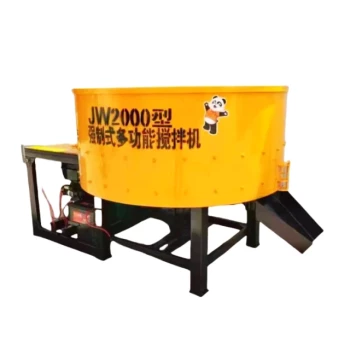Mixing and pouring concrete with a self loading concrete mixer involves a streamlined process that combines automated material handling, precise mixing, and controlled discharge. The key steps include preparing materials, loading them into the mixer, achieving the right consistency, and safely pouring the concrete. Advanced features like hydraulic systems, real-time weighing, and electronic controls ensure efficiency and quality, making these mixers suitable for both professionals and non-specialists. The process minimizes manual labor while maintaining industry-standard results.
Key Points Explained:
-
Material Preparation
- Gather aggregates (sand, gravel), cement, and water in the correct proportions based on the desired mix design.
- Ensure materials are free from debris or contaminants that could affect the final product.
-
Automated Loading
- The mixer’s loading system (bucket, conveyor, or hydraulic arm) transfers materials into the mixing drum.
- Sensors or weighing systems measure quantities in real-time to maintain accuracy.
-
Mixing Process
- The hydraulic system and electric motor drive the mixing blades to blend materials uniformly.
- Monitor the drum for consistency, adjusting speed or time to eliminate lumps or dry spots.
-
Water Management
- The integrated water system adds precise amounts, often controlled via touchscreen inputs.
- Adjustments can be made during mixing to achieve the ideal slump or workability.
-
Discharging Concrete
- Once mixed, the concrete is poured via a chute or conveyor belt directly at the site.
- The operator controls the flow to ensure even placement and minimize waste.
-
Post-Pour Steps
- Clean the mixer promptly to prevent hardened concrete buildup.
- Inspect components (blades, hydraulic lines) for wear or damage after use.
This process highlights how self-loading mixers simplify concrete production while ensuring reliability—whether for small-scale projects or demanding construction environments.
Summary Table:
| Step | Key Actions |
|---|---|
| Material Preparation | Gather aggregates, cement, and water in correct proportions; ensure cleanliness. |
| Automated Loading | Use the mixer’s loading system (bucket/conveyor) with real-time weighing. |
| Mixing Process | Blend uniformly via hydraulic-driven blades; adjust speed for consistency. |
| Water Management | Add precise water amounts via integrated system; adjust for slump. |
| Discharging Concrete | Pour via chute/conveyor with controlled flow for even placement. |
| Post-Pour Steps | Clean mixer promptly; inspect blades/hydraulics for wear. |
Upgrade your concrete workflow with GARLWAY’s self-loading mixers! Designed for contractors and construction firms, our mixers automate material handling, ensure precise mixing, and reduce labor costs. Contact us today to find the perfect solution for your project—whether for small sites or large-scale builds.
Related Products
- JZC400 Mobile Small Concrete Mixer Cement Mixer Machine
- Portable Ready Mix Concrete Mixer Equipment
- Portable Concrete Mixer Machine Equipment for Mixing Concrete
- Portable Electric Concrete Mixer Machine for Cement Mixing
- JW1000 Mobile Cement Mixer Concrete Mixer Truck and Batching Plant
People Also Ask
- What makes towable cement mixers suitable for certain projects? Portable, Efficient, and Adaptable Solutions
- What is the capacity of a small concrete mixer? Find the Perfect Size for Your Project
- Why are small concrete mixers particularly useful at construction sites? Boost Efficiency & Portability
- How does a mobile concrete mixer improve efficiency on construction sites? Boost Productivity & Cut Costs
- How do electric portable cement mixers differ from gas-powered ones? Key Differences Explained



















